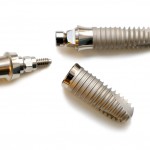
The clinical use of dental implants is widespread. However, standard dental implants require sufficient bone for their placement. While bone regeneration techniques are used in order to provide additional support one alternative is to place narrow diameter dental implants (NDIs). As NDIs have reduced contact area with bone compared with standard implants there are concerns regarding resistance and fatigue strength of these implants. A new titanium–zirconium alloy (Ti–Zr) with improved biomechanical properties may help address these concerns.
The aim of the present systematic review was to report on the clinical performance of Ti–Zr NDIs in clinical trials.
Methods
Searches were conducted in the Medline database supplemented with hand searches of the journals; International Journal of Periodontics and Restorative Dentistry, International Journal of Oral and Maxillofacial Implants, Journal of Periodontology, Implant Dentistry, Dentistry Today, Journal of Oral Implantology, Quintessence International, International Journal of Oral and Maxillofacial Surgery, Clinical Oral Implants Research, and Journal of Clinical Periodontology
Prospective studies including randomised-controlled and non-randomized controlled studies and cohort studies; retrospective studies including controlled studies, case–control studies, and single cohort studies with a follow-up period of at least 6 months were considered. Two reviewers selected studies abstracted data and assessed study quality independently and meta-analysis conducted. Implants with a diameter of 3-3.5mm were considered to be NDIs.
Results
- Nine studies were included; 2 RCTs, 6 prospective and 1 retrospective study.
- All the implants placed were were manufactured by the same company from a Ti–Zr alloy (Roxolid; Institut Straumann AG).
- 607 patients received 922 narrow diameter Ti–Zr implants.
- Follow-up ranged from 3 to 36 months
- Mean survival and success rates were 98.4% and 97.8% at 1 year after implant placement and 97.7% and 97.3% at 2 years.
- Mean marginal bone loss was 0.36±0.06mm after 1 year and 0.41±0.09mm after 2 years.
- Surgical complications described in these articles were limited to local inflammation.
- No implant fractures were reported.
Conclusions
The authors concluded
Narrow diameter Ti–Zr dental implants show high survival and success rates (>95%) and marginal bone level changes (<1 mm) that are comparable to those of regular diameter titanium implants in the short term (investigated follow-up periods of up to 36 months).
Comments
Only a single database has been searched for this review although the hand search of an number of the most common journals in which implant research is published has been carried out. It is possible however that searching additional databases may identify additional relevant studies. While the authors indicate that study quality was assessed no formal summary of this is presented in the main paper and while 8 of the 9 included studies were prospective only 2 were RCTs and other designs are more likely to suffer from bias. All the included studies used the same type of implant and suggest good outcomes at 2 years, which are similar to regular implants. Although these results should be interpreted with caution until high quality evidence from studies of longer duration is available
Links
Primary paper
Altuna P, Lucas-Taulé E, Gargallo-Albiol J, Figueras-Álvarez O, Hernández-Alfaro F, Nart J. Clinical evidence on titanium-zirconium dental implants: a systematic review and meta-analysis. Int J Oral Maxillofac Surg. 2016 Feb 3. pii: S0901-5027(16)00025-4. doi: 10.1016/j.ijom.2016.01.004. [Epub ahead of print] Review. PubMed PMID: 26852292.

Narrow dental implants – good survival at 2 years suggests review https://t.co/EZh8AhbXe6
Review found Narrow diameter Ti–Zr dental implants had high survival and success rates at 2 years https://t.co/EZh8AhbXe6
Mean survival rate of 97.7% at 2 years for narrow dental implants suggests review https://t.co/EZh8AhbXe6
Review suggests good survival rates for narrow dental implants at 2 years https://t.co/EZh8AhbXe6
Don’t miss- Narrow dental implants – good survival at 2 years suggests review https://t.co/EZh8AhbXe6